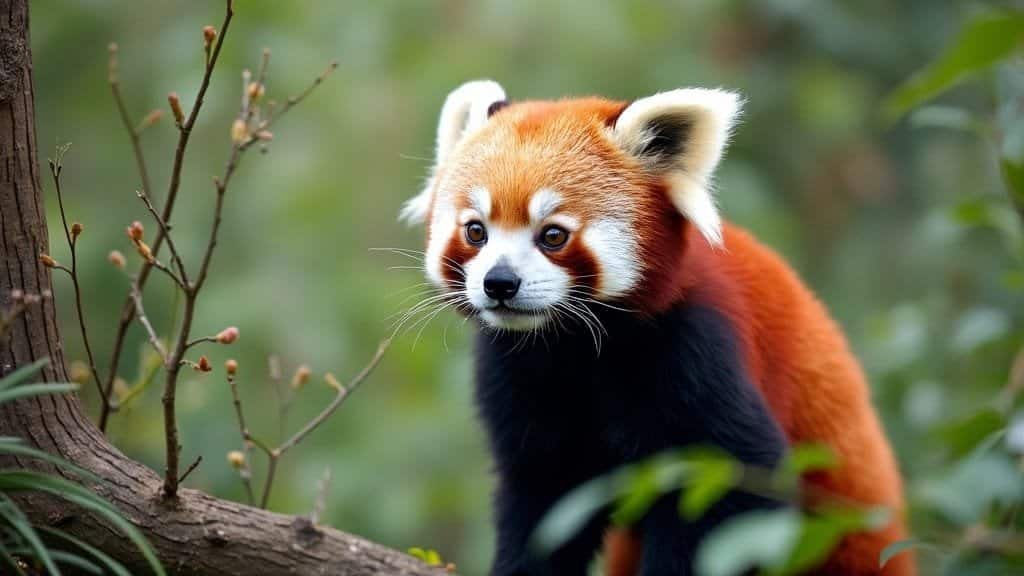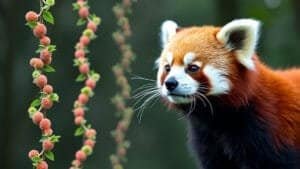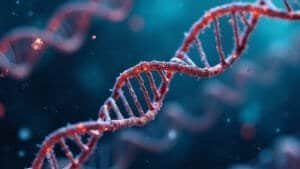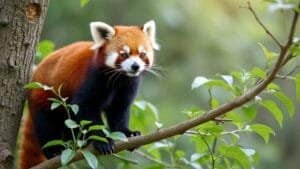Introduction
The red panda’s classification within the Ailuridae family highlights its evolutionary uniqueness and ecological importance
As the sole surviving member of this family, the red panda is distinctly separate from bears (Ursidae) and raccoons (Procyonidae), despite historical misclassifications. Advances in genetic and morphological studies have clarified its place in the mammalian tree of life, providing valuable insights into its evolutionary history and conservation needs
This article explores the role of the Ailuridae family in defining the red panda’s classification, its distinct traits, and the implications for understanding and protecting this endangered species
Understanding the Ailuridae Family in Mammalian Taxonomy
The Ailuridae family is central to understanding the classification of the red panda, highlighting its distinct evolutionary lineage within the order Carnivora
Despite its physical similarities to both bears (Ursidae) and raccoons (Procyonidae), the red panda occupies a unique taxonomic position, underscoring the importance of the Ailuridae family in mammalian taxonomy
What Is the Ailuridae Family?
The Ailuridae family is a small, specialized lineage within the order Carnivora. It consists of the red panda (Ailurus fulgens), the only extant (living) member, and several extinct species known from fossil records
Members of Ailuridae are characterized by a combination of carnivorous and herbivorous traits, most notably a diet heavily reliant on bamboo
This family belongs to the superfamily Musteloidea, which includes raccoons (Procyonidae), weasels (Mustelidae), and skunks (Mephitidae)
Despite this broader connection, genetic and morphological evidence shows that Ailuridae diverged early in Carnivora’s evolutionary history, establishing a distinct lineage separate from its relatives
Evolutionary Origins of Ailuridae and the Red Panda
The evolutionary roots of the Ailuridae family trace back approximately 20–25 million years, to the Miocene epoch. Fossil evidence suggests that early Ailurids were more carnivorous and arboreal than their modern descendant, the red panda
Over time, members of this lineage adapted to a bamboo-rich diet and developed specialized morphological traits, such as strong molars for grinding plant material and a pseudo-thumb for grasping bamboo
Notable extinct members of the Ailuridae family include species like Parailurus, which were larger and exhibited more generalist diets compared to the modern red panda
Fossils of these ancient Ailurids have been discovered across Europe, Asia, and North America, indicating a once-widespread distribution. The modern red panda’s restricted range in the Himalayan region reflects a significant contraction of the family’s historical habitat due to climate changes and habitat loss over millions of years
Distinguishing Ailuridae From Other Carnivore Families
One of the defining characteristics of the Ailuridae family is its blend of features typically associated with both carnivorous and herbivorous mammals. While red pandas belong to Carnivora, they exhibit unique dietary and anatomical adaptations that set them apart
Key Differences From Ursidae (Bears)
Dietary Specialization: Unlike bears, which are omnivorous with a strong inclination toward animal protein, red pandas are primarily herbivorous, relying almost exclusively on bamboo
Body Size and Structure: Red pandas are significantly smaller, with a more arboreal and agile body suited to tree-dwelling.
Genetic Divergence: Molecular studies confirm that red pandas and bears diverged approximately 40 million years ago, indicating a distant evolutionary relationship
Key Differences From Procyonidae (Raccoons)
Habitat Preferences: While raccoons are generalists found in diverse environments, red pandas are specialized for the cool, temperate forests of the Himalayas
Dietary Adaptations: Raccoons are opportunistic omnivores, whereas red pandas exhibit highly specialized bamboo-feeding adaptations
Morphological Features: Red pandas possess a pseudo-thumb and robust molars for processing plant material, traits not observed in raccoons
By occupying a unique niche within Carnivora, the Ailuridae family underscores the evolutionary adaptability and specialization of its members. Understanding this family’s distinct traits and origins is essential for appreciating the red panda’s ecological and evolutionary significance
The Red Panda’s Unique Classification in Ailuridae
The red panda’s classification within the Ailuridae family reflects its unique evolutionary adaptations and distinguishes it from other members of the order Carnivora
Understanding the defining traits of this classification sheds light on its ecological role, evolutionary history, and conservation priorities
Key Traits That Define the Red Panda in Ailuridae
The red panda’s classification as the sole extant member of the Ailuridae family is supported by distinct morphological and behavioral traits
These adaptations illustrate the species’ divergence from other carnivores and its specialization for a bamboo-based diet and arboreal lifestyle
Pseudo-Thumb
The red panda possesses a pseudo-thumb, an enlarged radial sesamoid bone that acts as an additional digit. This adaptation allows the red panda to grip bamboo stems effectively, facilitating its specialized diet
While a similar trait exists in giant pandas, the pseudo-thumbs evolved independently in these species, demonstrating convergent evolution
Dietary Specialization
Despite being a member of Carnivora, the red panda is almost entirely herbivorous, consuming bamboo as its primary food source. Adaptations supporting this diet include robust molars for grinding plant material and a highly efficient digestive system adapted to process cellulose
These traits highlight the ecological specialization that sets the red panda apart from other carnivores
Fur and Camouflage
The red panda’s thick reddish-brown fur provides insulation in its cold Himalayan habitat and serves as camouflage against the mossy and lichen-covered trees where it resides. This trait is uniquely suited to its arboreal and temperate forest environment
Behavioral Characteristics
Red pandas are solitary, nocturnal, and arboreal, traits that reflect their evolutionary history within Ailuridae. Their territorial nature and reliance on dense forest cover further emphasize their specialization as a species adapted to a niche environment
Historical Misclassifications and Their Resolution
The red panda’s classification history has been the subject of much scientific debate. Initially described in 1825, the red panda was thought to be closely related to raccoons (Procyonidae) due to similarities in skull shape, tail rings, and arboreal behavior
Others argued that it belonged to the bear family (Ursidae), given its dietary similarities to the giant panda and its membership in Carnivora
However, advances in molecular biology and genetic sequencing resolved this debate. Studies published in Molecular Ecology (2021) confirmed that the red panda belongs to its own distinct family, Ailuridae, diverging from a common ancestor with Procyonidae and Ursidae approximately 40 million years ago
These findings underscored the red panda’s unique evolutionary path, separate from both raccoons and bears
Genetic Studies Supporting the Ailuridae Classification
Genomic analyses have been pivotal in defining the red panda’s classification. Comparative studies of mitochondrial and nuclear DNA reveal distinct genetic markers that separate Ailuridae from other carnivore families
Key findings include:
Divergent Lineage: The red panda’s genetic distance from raccoons and bears highlights its early divergence within the Carnivora order
Bamboo Diet Genes: Specific genes linked to cellulose digestion and bamboo detoxification reflect the red panda’s dietary specialization, reinforcing its unique niche
Adaptive Traits: Genes associated with thermoregulation and arboreal locomotion further support the red panda’s classification as a distinct family
These genetic insights confirm that the red panda’s traits are a product of millions of years of independent evolution, cementing its place as the sole surviving member of the Ailuridae family
By understanding the red panda’s classification, scientists can better appreciate its ecological role and prioritize conservation efforts tailored to its unique adaptations and vulnerabilities
Ecological and Conservation Implications of Ailuridae
The red panda’s classification within the Ailuridae family has profound implications for its ecological role and conservation
As the last surviving member of this lineage, the red panda embodies a distinct evolutionary legacy that highlights the importance of protecting not only the species itself but also the ecosystems it depends on
How Ailuridae Influences the Red Panda’s Ecological Role
As a member of the Ailuridae family, the red panda plays a unique role in its ecosystem. Its dietary specialization on bamboo and arboreal behavior contribute to the health and balance of the Himalayan and southwestern Chinese forests where it resides
Bamboo Regulation
By feeding selectively on bamboo shoots, leaves, and stems, red pandas help regulate bamboo growth and prevent over-dominance in their habitat. This natural pruning supports the overall biodiversity of the forest, creating space for other plant species to thrive
Seed Dispersal and Nutrient Cycling
While primarily herbivorous, red pandas occasionally consume fruits, which makes them important seed dispersers. Their droppings also contribute to nutrient cycling in forest soils, supporting the growth of vegetation
Prey-Predator Dynamics
Although rarely preyed upon due to their arboreal lifestyle, red pandas are part of a larger food web. Predators like snow leopards occasionally target red pandas, linking their presence to the ecological dynamics of predator-prey relationships in their habitats
The distinct ecological niche occupied by the red panda reflects the specialized role of the Ailuridae family, emphasizing the importance of maintaining its habitat to support this balance
The Importance of Recognizing Ailuridae in Conservation Efforts
Recognizing the red panda’s classification within Ailuridae is essential for conservation strategies tailored to its unique traits and vulnerabilities. This understanding ensures that efforts focus on preserving the specific ecological conditions that support the species
Habitat Protection
Conservation programs informed by the red panda’s arboreal and dietary needs prioritize protecting bamboo-rich forests and minimizing habitat fragmentation. Maintaining the integrity of these ecosystems is critical for sustaining red panda populations
Genetic Diversity
As the only surviving member of its family, the red panda’s genetic diversity is crucial for the long-term survival of the lineage. Conservation initiatives, such as managed breeding programs in zoos, aim to preserve genetic variation to prevent inbreeding and ensure resilience against environmental changes
Flagship Species for Ecosystem Conservation
The red panda’s status as the last representative of Ailuridae makes it a flagship species for conservation efforts in its native range. Protecting red pandas benefits other species that share their habitat, from small mammals to birds and insects, contributing to broader biodiversity preservation
Fossil Insights Into Extinct Ailuridae Members
The fossil record of the Ailuridae family provides valuable insights into the evolutionary history of the red panda and its extinct relatives
Fossils of early Ailurids, such as Parailurus, reveal traits that link the red panda to its carnivorous ancestors while highlighting the gradual shift toward herbivory
Diverse Adaptations in Ancient Ailurids
Fossils suggest that early members of Ailuridae were larger and more omnivorous than modern red pandas. These traits indicate a greater ecological flexibility, which likely helped the family adapt to diverse environments before becoming specialized
Geographic Distribution
Fossil evidence of Ailuridae species has been found across Asia, Europe, and North America, suggesting a much broader historical range. This contrasts sharply with the red panda’s current restricted distribution, underscoring the impact of climate change and habitat loss over millions of years
Studying extinct Ailurids helps scientists understand the evolutionary pressures that shaped the red panda’s adaptations, offering insights into how to safeguard the species in a rapidly changing world
Conclusion
The red panda’s classification within the Ailuridae family underscores its unique evolutionary journey and ecological significance
As the sole surviving member of this lineage, the red panda represents a distinct branch of the Carnivora order, shaped by millions of years of adaptation to a highly specialized niche
Its arboreal behavior, bamboo diet, and anatomical features, such as the pseudo-thumb, highlight the evolutionary ingenuity of the Ailuridae family
Recognizing the red panda’s place in Ailuridae is not only a matter of scientific interest but also a cornerstone for its conservation. By understanding its classification, researchers can tailor conservation efforts to address the species’ specific needs, including protecting bamboo-rich habitats, maintaining genetic diversity, and mitigating threats like habitat fragmentation and climate change
Fossil records of extinct Ailuridae species further enrich our understanding of the family’s historical diversity and geographic range, emphasizing the red panda’s role as a living link to a once-widespread lineage
Safeguarding this species ensures the survival of a unique evolutionary legacy and supports the broader ecosystems that depend on the balance it helps maintain
Through continued research and targeted conservation, the Ailuridae family’s contribution to the natural world can be preserved for future generations, embodied in the enduring charm and ecological importance of the red panda





